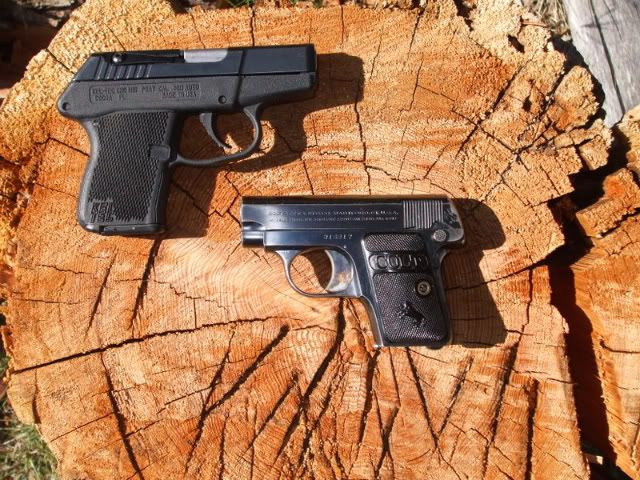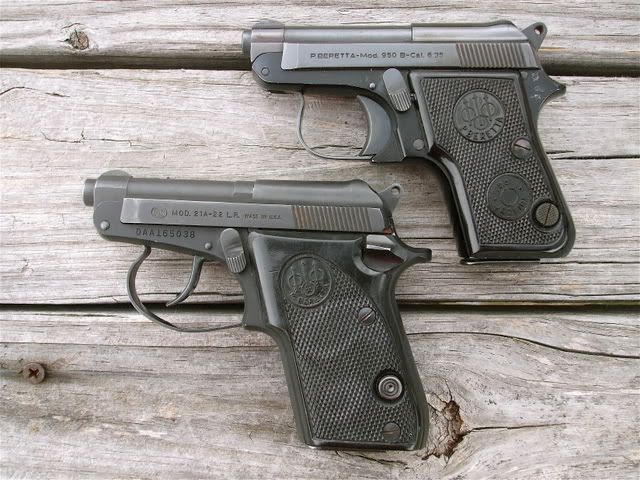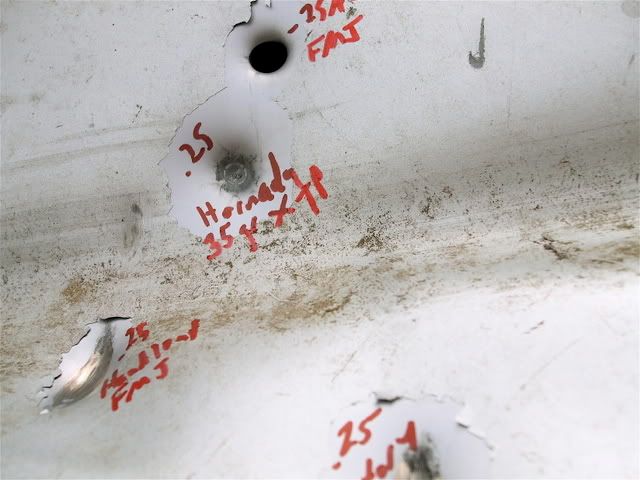I satisfied my mind about the .25 vs. .22 debate a couple of years ago with some contrived "non-tests" which I stuck on some forums. Here it is in all its long-windedness and complete with photographic "proof."
______________________________
How many folks out there are going to admit to having a handgun chambered for the .25 ACP? If ownership of the .25 ACP is admitted then how many have actually carried a handgun so chambered? It’s a cartridge that is frequently criticized as being too unsubstantial for use for serious self-defense, yet ammunition is sold each year for this pipsqueak . Somebody’s using it for something.
The .25 ACP is one of our really old semi-auto pistol cartridges. It was introduced in 1905 or 1906, depending on the reference, in the FN Model 1906. Both pistol and cartridge were of Browning design. Once the semi-auto pistol became accepted and came in general use at the beginning of the 20th century, a number of designs in different sizes and chambered for a host of new cartridges were marketed to those who felt the need to possess a handgun for self-defense. The smallest practical sizes marketed were any of several models termed vest pocket pistols. Most of these were designed around the .25 ACP or 6.35 Browning as it is known in Europe. These diminutive pistols occupied about the same space as the smallest one or two shot derringers of the previous century but featured higher ammunition capacity contained in handy magazines that made recharging more convenient. Due to the relatively high velocity of the .25 ACP cartridge, handguns so chambered offered striking effectiveness equal or exceeding many of the low-powered rim fire, pin fire, or center fire pocket pistols marketed in the later decades of the 19th century. A light-weight-for-caliber .22, .25, .30, .32, .38, or at best .41 caliber bullet traveling at 400-500 fps is anemic in the extreme. Many thousands of small semi-auto pistols taking the .25 ACP were sold worldwide over the next 75 years or so. Among the well known brands were some really fine handguns made and sold in .25 ACP including Astra, Beretta, Browning, Colt, FN, Mauser, Ortgies, Sauer, and Walther. These are finely made and exhibit design and craftsmanship fully equal to larger handguns from those firms.
GCA ’68 and a change in tastes caused the popularity of high quality arms chambered for the .25 ACP to wan by the 1970’s. The cartridge became the provenance of the inexpensive semi-auto pistol. It seems that such low quality pistols, with their uneven functional reliability, further tarnished the reputation of the .25 as a serious defensive cartridge. Design advancements in the 1980’s and 1990’s made more powerful cartridges available in pistols almost as small as many .25 pistols. These days there are not a lot of choices out there if one wants to purchase a new .25 pistol.
So, What Can It Do?
For starters the .25 fully possesses the capability to kill a person very dead. It has laid many low in it’s century plus usage. It must be remembered that the .25 pistol is not a toy and absolutely must be accorded the same respect that any firearm should be given.
I’ve toted and used the .25 on occasion and have some notion of its capabilities. Upon considering the Kel Tec P3AT, it’s .380 ACP cartridge, and it’s overall size compared to my Colt Model 1908 I decided to retire the .25 as a deep concealment handgun and go with the P3AT and its more effective cartridge. Previously I’d slipped the little Colt in my hip pocket behind my wallet if I didn’t think I could contrive to hide anything larger.

Years ago I saw my first example of .25 ACP effectiveness and it was sorry indeed. I’d left a hunting vest on a tank dam where I’d been dove hunting one afternoon. Before work the next morning I drove out past the edge of town to the pasture to retrieve the vest. I slipped my Beretta Model 1919 .25 ACP behind my wallet and began hiking up a fence row to the stock tank. About 300 yards up the path from the road I suddenly found myself face to face with a coyote which was sitting on it’s haunches in the broom weeds at the edge of the path I was traveling. Pleased to have an opportunity to rid the countryside of one of the varmints I whipped out the .25 pistol and fired full into the center of the coyote’s chest, seeing dust and fur fly where the bullet struck. The distance couldn’t have been more than 5 yards. The coyote whirled and ran off. I’m sure I could ascertain a baleful look in its eye as it turned to run, contemptuous of my ordnance.
Someone once dumped an old washing machine in a gully on our gun club property. I took advantage of the opportunity to fire a few shots into its side with this .25 Beretta. The result was chipped paint and deep puckers. No bullet penetrated the side of the washer. A few more shots with a Smith & Wesson Model 17 .22 Long Rifle revolver penetrated the washer’s side. What was this? The .22 would pierce the sheet metal. I knew the Beretta was old, its bore ravaged by corrosive priming. The rifling was only a shadow in the pitted surfaces of the bore. I speculated that bore condition could be affecting my .25’s effectiveness.
At the next Fort Worth gun show I swapped the Beretta and cash for a Colt Model 1908 .25 that had a sparkling clean bore Since the washer was still at the range I stopped by and fired some more .25 ammo at its side. The shots from the Colt completely penetrated the sheet metal. Moral to the story is: if ya’ pistole ain’t got much horsepower to begin with, be sure it’s in good condition ‘cause you’re gonna need all the help you can get.
One evening my brother-in-law Bo called me to talk handloading and guns. I was walking around in the house on the cordless phone while visiting with him and happened to look out our front door. There on the porch sat a feral cat that I’d been gunning for. With no explanation other than “Hang on Bo” I held the phone against my chest with my left hand, fetched the .25, which happened to be nearby, eased the door open a crack, and popped the cat through both shoulders. The bullet exited and made a small, flaked mark on the concrete. The cat launched itself off the porch but immediately keeled over at the edge of the sidewalk in the grass. He’d traveled about 8 feet. He was about 10 feet from the muzzle of the Colt when I fired. Bo exclaimed, “What was that?” I replied that I’d just taken out a cat that was hanging around tormenting Wally, our kids’ new kitten.
I used the Colt .25 to administer a finishing shot to a buck once. I’d hit a buck deer high in the spine on a broadside shot with a .30-30 as he trotted through the edge of some oak woods. He was down but not out so I placed the .25 down close to the back of his head and pressed the trigger. As the shot rang out I observed the spent .25 FMJ bullet roll out of his right nostril onto the leaves, completely undamaged except for the rifling marks. The .25 effectively administered the coup de grace but was completely spent in traversing the deer’s head.
A few armadillos, ‘possums, and a ‘coon that was found beneath our camper on a deer lease have given their all to my .25 ACP and it proved to be effective on these varmints.
A Stinker to Shoot
I’ve owned an Astra Model 1916 (?), a Helfricht Model 3, a couple of Colt Model 1908 .25 pistols and a Browning Baby since I traded out of that old Beretta. I get a kick out of shooting the diminutive pistols but can’t say I’m good at it. The sights are rudimentary, the triggers are a chore, and there just isn’t much for me to hold onto. The Browning Baby was about as tedious as shooting a .44 Magnum with full power loads because of this. The Colt Model 1908 seems to offer a bit more to hold. All .25 ACP pistols are loud enough to ring one’s ears if hearing protection is not worn. Despite the small pistols’ general unsuitability for use I’ve been know to wile away part of an afternoon trying to shoot distant targets with them for fun. There’s a good-sized mesquite tree at the end of the road leading to the lake cabin that is slightly smaller in diameter than a skinny man. The distance is around 100 yards from the cabin yard. It’s possible but not easy to chip and nick the bark on the tree with .25 bullets. The last time I played at this game I had my best results shooting prone.
Oh the Raw Power
The traditional factory ballistic figures quoted for the .25 ACP with it’s standard 51 grain full metal jacketed bullet is 760 fps with 64 ft./lbs. of energy. Most consider the .25 ACP to be inferior to the .22 Long Rifle for self defense. This isn't entirely true as may be seen. It’s one thing to fire a .22 Long Rifle from a handgun with a four inch to eight inch barrel yet quite another to fire it from a typical vest pocket pistol with it’s barrel length of perhaps two inches at most. Perspectives change when firing both cartridges from similar handguns. It is said that the .25 ACP feeds more reliably than the longer rimmed .22 Long Rifle. There may be some truth to that statement as my .25 ACP semi-auto pistols have fed and functioned with perfect reliability.
Because some folks are gluttons for punishment, die sets for handloading the .25 are available. Picking out .25 ACP cases from the typical litter of .22 rim fire cases on the ground at the range is enough to make one cross-eyed. Once set up for handloading the tiny components aren’t quite as bad to handle as may be imagined. I handload for the .25 ACP as I must have a low threshold of entertainment. My RCBS Uniflow powder measure can just be adjusted to reliably throw the maximum listed charge of Unique. It won’t go any lower and is easier to set just a little over the maximum listed charge weight for Unique. I’ve only attempted to load Bullseye and Unique in the .25 ACP. I’d assumed that Bullseye would be the best choice but Unique gives higher velocities using maximum published loads. The .25 ACP would have to be the least expensive cartridge of all to handload if one troubled himself to cast bullets for it. I’m just not that dedicated.
The Inevitable Tests
Bo and I once spent a pleasant afternoon testing the .25 ACP and the .22 Long Rifle in a pair of Berettas he has. These two pistols have barrels of the same length. Below find data from the afternoon's tests along with some additional .25 ACP data including handloads.

.25 ACP Factory loads
Remington 51 grain FMJ, MV 789 fps, ME 71 ft./lbs.
Winchester 50 grain FMJ, MV 852 fps, ME 82 ft./lbs.*
Hornady XTP 35 grain hollowpoint MV 1004 fps, ME 78*
.25 ACP Handloads
Remington 51 grain bullet, 1.6 grains Unique, MV 853 fps, ME 82 ft./lbs.
Remington 51 grain bullet, 1.2 grains Bullseye, 728 fps, ME 60 ft./lbs.
Rem. 51 grain bullet, (can't tell-it's a secret) Unique, MV 933 fps, ME 99 ft./lbs.
Selected .22 Long Rifle cartridges fired from a Beretta Model 21A
Remington high-velocity copper plated 40 grain solid (Golden Bullet)*
MV 842 fps, ME 63 ft./lbs.
Remington high-velocity lead 36 grain hollow point*
MV 865 fps, ME 60 ft./lbs.
Winchester high-velocity lead 40 grain solid*
MV 854 fps, ME 65 ft./lbs.
Winchester high-velocity copper plated 36 grain hollow point*
MV 894 fps, ME 64 ft./lbs
A Colt Model 1908 and a Oehler Model 12 chronograph were used except (*) in which a Beretta Model 950 B .25 ACP and a Beretta Model 21A .22 Long Rifle were tested over a Chrony chronograph. Coincidentally, the Winchester factory 50 grain load checked out identically when fired from both the Colt and the Beretta and the Unique handload was only one foot per second faster.
When considering the midget automatics I'd prefer the .25 ACP to the .22 Long Rife though the difference is so minuscule as to be pointless. The .25 ACP feeds more reliably, the heavier and slightly larger .25 bullet shows equivalent velocities, and the fully jacketed design should deform less and offer more penetration. In tests against the '92 Dodge pickup fender the .25 ACP was noticeably more reliable in penetrating it than was the .22 Long Rifle when fired from the short barreled pistols. Neither was 100% successful in penetrating the fender. Not sure just what this test on the fender proves.

If one is required to utilize the .25 ACP for self-defense the original 51 grain loading looks like the best bet in my view. Lately the standard full metal jacketed bullet is listed as 50 grains. The cartridge will never have the reputation as a stopper. In order for it to do it’s best work it needs to penetrate to a vital organ. The lighter weight, expanding bullets offered by some ammunition manufacturers in an effort to provide “enhanced performance” appear to me to be more likely to fail to adequately penetrate. Some of these are: 40 grain Glazer Safety Slug, 45 grain Winchester Super-X Expanding Point, 35 grain Hornady XTP hollow point, and 35 grain Speer Gold Dot hollow point. The whiz-bang fancy .25 slug that expands effectively won’t do much good if it opens up and stops in the lining of a winter jacket or perhaps a rib bone or skull, leaving an assailant who is even more agitated. I’ve had no experience with any “high performance” .25 ACP ammunition so am not qualified to say what it would do. What’s more, I don’t intend to purchase a bunch of different brands order to find out what they could do. Penetration would be the first priority when selecting ammunition to carry in these pistols.
If it's all one has in his possession, a .25 ACP pistol could certainly be pressed into service for defense. It’d be better than nothing. A well-thrown punch generates more foot-pounds of energy but one must close with the adversary in order to land a blow. Since very small pistols are now available in more powerful cartridges there isn't really place for the .25 ACP in one’s self defense arsenal. It’s appeal in the 21st century lies in the collectors' fascination for the finely finished examples of the miniature handguns made in this chambering.
Now if I could only find a nice example of one of those scarce Walther PP’s chambered for .25 ACP…